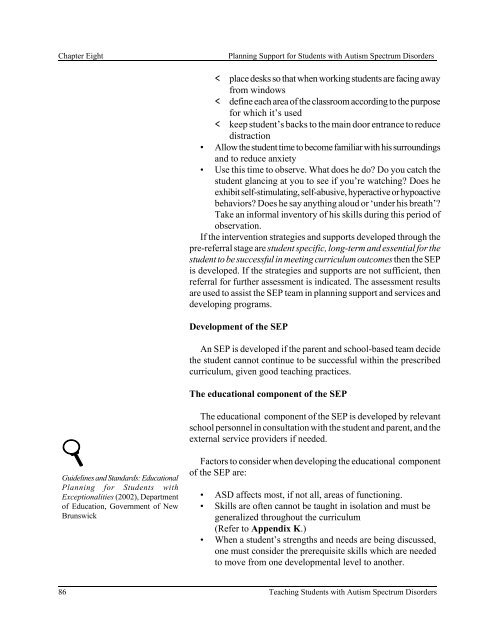Teaching Students with Autism Spectrum Disorders
Teaching Students with Autism Spectrum Disorders
Teaching Students with Autism Spectrum Disorders
You also want an ePaper? Increase the reach of your titles
YUMPU automatically turns print PDFs into web optimized ePapers that Google loves.
Chapter Eight Planning Support for <strong>Students</strong> <strong>with</strong> <strong>Autism</strong> <strong>Spectrum</strong> <strong>Disorders</strong><br />
Guidelines and Standards: Educational<br />
Planning for <strong>Students</strong> <strong>with</strong><br />
Exceptionalities (2002), Department<br />
of Education, Government of New<br />
Brunswick<br />
< place desks so that when working students are facing away<br />
from windows<br />
< define each area of the classroom according to the purpose<br />
for which it’s used<br />
< keep student’s backs to the main door entrance to reduce<br />
distraction<br />
• Allow the student time to become familiar <strong>with</strong> his surroundings<br />
and to reduce anxiety<br />
• Use this time to observe. What does he do? Do you catch the<br />
student glancing at you to see if you’re watching? Does he<br />
exhibit self-stimulating, self-abusive, hyperactive or hypoactive<br />
behaviors? Does he say anything aloud or ‘under his breath’?<br />
Take an informal inventory of his skills during this period of<br />
observation.<br />
If the intervention strategies and supports developed through the<br />
pre-referral stage are student specific, long-term and essential for the<br />
student to be successful in meeting curriculum outcomes then the SEP<br />
is developed. If the strategies and supports are not sufficient, then<br />
referral for further assessment is indicated. The assessment results<br />
are used to assist the SEP team in planning support and services and<br />
developing programs.<br />
Development of the SEP<br />
An SEP is developed if the parent and school-based team decide<br />
the student cannot continue to be successful <strong>with</strong>in the prescribed<br />
curriculum, given good teaching practices.<br />
The educational component of the SEP<br />
The educational component of the SEP is developed by relevant<br />
school personnel in consultation <strong>with</strong> the student and parent, and the<br />
external service providers if needed.<br />
Factors to consider when developing the educational component<br />
of the SEP are:<br />
• ASD affects most, if not all, areas of functioning.<br />
• Skills are often cannot be taught in isolation and must be<br />
generalized throughout the curriculum<br />
(Refer to Appendix K.)<br />
• When a student’s strengths and needs are being discussed,<br />
one must consider the prerequisite skills which are needed<br />
to move from one developmental level to another.<br />
86 <strong>Teaching</strong> <strong>Students</strong> <strong>with</strong> <strong>Autism</strong> <strong>Spectrum</strong> <strong>Disorders</strong>

















